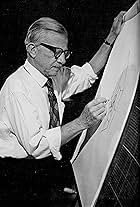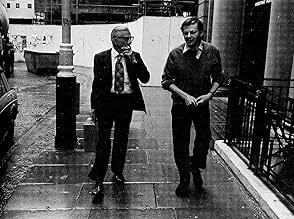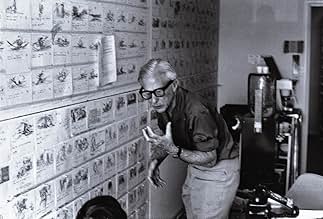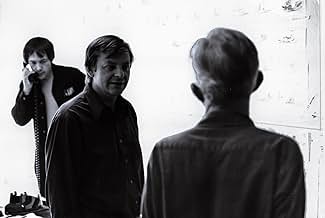Art Babbitt(1907-1992)
- Animation Department
- Director
- Writer
Art Babbitt (born Arthur Harold Babitsky) was an American animator and animation director from Omaha, Nebraska. He worked in several animation studios over his long career, but is mostly remembered for his early work for the Walt Disney Animation Studios. During the 1930s, Babbitt redesigned and developed the character of Goofy. In his view, Goofy was a composite character: "a composite of an everlasting optimist, a gullible Good Samaritan, a half-wit, a shiftless, good-natured hick". Babbitt was credited as the main animator for the Evil Queen in "Snow White and the Seven Dwarfs" (1937), and for Geppetto in "Pinocchio" (1940).
In 1907, Babbitt was born to a Jewish family in Little Bohemia, Omaha. It was a neighborhood of Omaha which had a large population of Czech emigrants from Austria-Hungary since the 1880s. By the time he finished kindergarten, his family decided to move to Sioux City, Iowa. His father was paralyzed in an accident at work, forcing Babbitt to become a breadwinner at an early age.
In the late 1920s, Babbitt had decided to follow the career of an animator. At the time, the industry was providing career opportunities for hopeful young artists. In 1929, Babbitt was among the first animators hired by a new animation studio, Terrytoons (1929-1973). The studio had been established by experienced animator Paul Terry, and its headquarters were located in Long Island, New York.
In 1932, Babbitt applied for a job at the Walt Disney Animation Studios in Los Angeles. The studio was more prestigious than Terrytoons, and was reputed to offer better salaries for its top talents. Babbitt was initially hired as an assistant animator, but was soon promoted to a regular animator in recognition of his talents. He was put to work in animated short films, helping animate characters such as Mickey Mouse, Pluto, and the Big Bad Wolf.
When the studio started working on its first animated feature film, "Snow White and the Seven Dwarfs" , Babbitt was entrusted with animating the Evil Queen. It was one of the toughest assignments on the film, as the character was not rotoscoped (unlike several of the others). There was an effort to make the character "regally beautiful", to have her movements be graceful, and for her emotions to be primarily expressed through her lovely mouth and eyes. Babbitt and his assistants reportedly produced enough drawings of the Queen to fill a paper house.
His efforts on the feature film were rewarded with a salary increase. Babbitt was one of the highest-paying jobs in the studio. For the first time in his life, he could afford a large house, three cars, and two servants. At about this time, Babbit married his first wife. She was the actress and dancer Marge Champion (1919-2020). She had been hired as a dance model for "Snow White and the Seven Dwarfs", and had impressed Babbitt. Their marriage only lasted to 1940, ending in divorce.
During the late 1930s, Babbitt worked on two other feature films "Pinocchio" and "Fantasia". He animated Geppetto in "Pinocchio", the protagonist's father. He also designed several characters for two segments of Fantasia: "The Nutcracker Suite" and "The Pastoral Symphony". Among his creations were Disney's versions of the gods Zeus, Vulcan, and Boreas.
In 1941, came the Disney animators' strike. Many of the studio's animators wanted to unionize in order to achieve better working conditions. Babbitt became one of the strike's leaders, though he was primarily campaigning for the rights of others and not his own self-interest. At one point, Babbitt and studio head Walt Disney nearly had a fist fight over a verbal insult. Studio staff intervened to stop them.
Following the strike, Babbitt and Walt Disney continued working together for a while, despite their mutual distrust and hostility. Babbitt found a friendlier working environment at his next employer, Warner Bros. Cartoons. His career was interrupted for a few years by military service in the Pacific War. In the post-war years, Babbitt was among the early staff of the animation studio United Productions of America (UPA, 1941-2000). The studio had been established by former Disney personnel, and Babbitt found himself working alongside former colleagues.
UPA was noted for its "very flat" and stylized designs, in contrast with Disney's style. They were considered as one of the most innovative animated studios of the late 1940s and early 1950s. Babbitt worked on several of their award-winning shorts until 1955. He subsequently acquired partial ownership of Quartet Films, a studio primarily working on television commercials.
Over the following decades, Babbitt rarely worked on theatrical films. But he was eventually hired by animator Richard Williams (1933-2019) to serve as the lead animator for the unfinished feature film "The Thief and the Cobbler". Babbitt designed several of the film's characters. The film was in production from 1964 until 1993, and was eventually released in a partially finished form. Babbitt did not live long enough to finish the film or to see it released. During that film's production, Babbitt also provided some character animation for "Raggedy Ann & Andy: A Musical Adventure" (1977).
In the early 1990s, Babbitt was invited by executive Roy E. Disney (Walt's nephew) to reconcile himself with Disney and its staff. Babbitt had reunions with his former rivals Frank Thomas and Ollie Johnston. He died in March 1992, at the age of 84. He was buried at the Forest Lawn Memorial Park, located in Hollywood Hills. Babbitt was posthumously named a Disney Legend in 2007. A small collection of Babbitt's personal films and home movies was eventually acquired by the Academy Film Archive. Babbitt is long gone, but continues to have a high reputation among animation historians and fans of American animation.
In 1907, Babbitt was born to a Jewish family in Little Bohemia, Omaha. It was a neighborhood of Omaha which had a large population of Czech emigrants from Austria-Hungary since the 1880s. By the time he finished kindergarten, his family decided to move to Sioux City, Iowa. His father was paralyzed in an accident at work, forcing Babbitt to become a breadwinner at an early age.
In the late 1920s, Babbitt had decided to follow the career of an animator. At the time, the industry was providing career opportunities for hopeful young artists. In 1929, Babbitt was among the first animators hired by a new animation studio, Terrytoons (1929-1973). The studio had been established by experienced animator Paul Terry, and its headquarters were located in Long Island, New York.
In 1932, Babbitt applied for a job at the Walt Disney Animation Studios in Los Angeles. The studio was more prestigious than Terrytoons, and was reputed to offer better salaries for its top talents. Babbitt was initially hired as an assistant animator, but was soon promoted to a regular animator in recognition of his talents. He was put to work in animated short films, helping animate characters such as Mickey Mouse, Pluto, and the Big Bad Wolf.
When the studio started working on its first animated feature film, "Snow White and the Seven Dwarfs" , Babbitt was entrusted with animating the Evil Queen. It was one of the toughest assignments on the film, as the character was not rotoscoped (unlike several of the others). There was an effort to make the character "regally beautiful", to have her movements be graceful, and for her emotions to be primarily expressed through her lovely mouth and eyes. Babbitt and his assistants reportedly produced enough drawings of the Queen to fill a paper house.
His efforts on the feature film were rewarded with a salary increase. Babbitt was one of the highest-paying jobs in the studio. For the first time in his life, he could afford a large house, three cars, and two servants. At about this time, Babbit married his first wife. She was the actress and dancer Marge Champion (1919-2020). She had been hired as a dance model for "Snow White and the Seven Dwarfs", and had impressed Babbitt. Their marriage only lasted to 1940, ending in divorce.
During the late 1930s, Babbitt worked on two other feature films "Pinocchio" and "Fantasia". He animated Geppetto in "Pinocchio", the protagonist's father. He also designed several characters for two segments of Fantasia: "The Nutcracker Suite" and "The Pastoral Symphony". Among his creations were Disney's versions of the gods Zeus, Vulcan, and Boreas.
In 1941, came the Disney animators' strike. Many of the studio's animators wanted to unionize in order to achieve better working conditions. Babbitt became one of the strike's leaders, though he was primarily campaigning for the rights of others and not his own self-interest. At one point, Babbitt and studio head Walt Disney nearly had a fist fight over a verbal insult. Studio staff intervened to stop them.
Following the strike, Babbitt and Walt Disney continued working together for a while, despite their mutual distrust and hostility. Babbitt found a friendlier working environment at his next employer, Warner Bros. Cartoons. His career was interrupted for a few years by military service in the Pacific War. In the post-war years, Babbitt was among the early staff of the animation studio United Productions of America (UPA, 1941-2000). The studio had been established by former Disney personnel, and Babbitt found himself working alongside former colleagues.
UPA was noted for its "very flat" and stylized designs, in contrast with Disney's style. They were considered as one of the most innovative animated studios of the late 1940s and early 1950s. Babbitt worked on several of their award-winning shorts until 1955. He subsequently acquired partial ownership of Quartet Films, a studio primarily working on television commercials.
Over the following decades, Babbitt rarely worked on theatrical films. But he was eventually hired by animator Richard Williams (1933-2019) to serve as the lead animator for the unfinished feature film "The Thief and the Cobbler". Babbitt designed several of the film's characters. The film was in production from 1964 until 1993, and was eventually released in a partially finished form. Babbitt did not live long enough to finish the film or to see it released. During that film's production, Babbitt also provided some character animation for "Raggedy Ann & Andy: A Musical Adventure" (1977).
In the early 1990s, Babbitt was invited by executive Roy E. Disney (Walt's nephew) to reconcile himself with Disney and its staff. Babbitt had reunions with his former rivals Frank Thomas and Ollie Johnston. He died in March 1992, at the age of 84. He was buried at the Forest Lawn Memorial Park, located in Hollywood Hills. Babbitt was posthumously named a Disney Legend in 2007. A small collection of Babbitt's personal films and home movies was eventually acquired by the Academy Film Archive. Babbitt is long gone, but continues to have a high reputation among animation historians and fans of American animation.

























